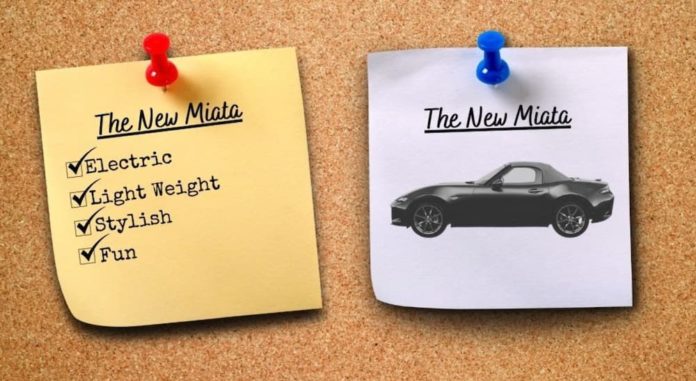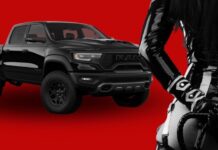Since its introduction in 1989, the Mazda MX-5 Miata has been one of the world’s most beloved sports cars. This lightweight roadster is a brilliant combination of British tradition, American ingenuity, and Japanese engineering – and for its current generation (known as the ND by enthusiasts), the Miata even added a healthy dose of Italian styling thanks to its collaboration with Fiat. But hold onto your seats because, according to our inside source in Hiroshima, things are getting a little crazy for the upcoming fifth-generation “NE” Miata.
A Changing Car for a Changing World
The leaks we’ve gotten from our sources are based on internal discussions at Mazda, and our understanding is that the company is still in the very early stages of planning its next-generation roadster. So don’t expect everything we mention here to make it into production. However, the major points of the new design seem to have been settled, and Mazda is already prototyping some of the radical design concepts that will set our favorite roadster up for success in the coming years.
Back in June, the car world got its first hints that a next-generation Miata was in the works with a widely circulated report that the Miata, along with the rest of the Mazda lineup, would be electrified by 2030. While this should not come as a surprise to anyone with an ear to the ground of the automotive industry, the news was greeted by a wave of despair by car enthusiasts. Why? Weight.
The Miata mystique is based on the car’s insanely low weight – just 2,341 pounds for the base 2021 Miata Sport. In an era where performance cars keep packing on the pounds (the new BMW M4 weighs in at 3,979 pounds on top of having its… distinctive… nose), the Miata is a breath of fresh air and a throwback to the days of lightweight and tossable sports cars. However, electrification means batteries, and batteries means weight.
Currently, there are no EVs on the market that weigh under 3,000 pounds (even the compact Nissan Leaf 3,501 pounds), much less under 2,400 pounds. So when Miata fanatics heard that their beloved roadster was going electric, they predicted the end of the car’s glorious history.
But this is Mazda we’re talking about – did you really think they were going to turn the Miata into another bloated pig of a family sedan masquerading as a sports car? Of course not.
Back to Their Roots
Poetically, the secret to success lay in Mazda’s roots as a cork company. In order to build an electric car that could live up to the Miata spirit, the engineers knew they would have to do something radically different. After well over a year of exploring alternative concepts, they settled on a unique cork-composite material wrapped around an aluminum frame.
While more conventional materials such as carbon fiber and advanced polymers were also considered, the problem was that they would have raised the cost of the Miata well beyond its current affordable price point. Instead, Mazda chose to build on recent material advances pioneered for low-signature warship construction.
It might surprise readers to learn that some of the most advanced warships in the world actually incorporate large amounts of wood composites into their structure. The Japanese Maritime Defense Force actually operated the largest wooden-hulled warships of the 21st century with the Yaeyama-class minesweepers, and the United States Navy recently commissioned the Zumwalt-class destroyers, which incorporate a superstructure constructed of balsa-wood composites. The extensive use of composite materials reduces the radar and magnetic signatures of these ships, making them harder to detect and safer from many modern weapons.
Now, Mazda obviously wasn’t concerned about having the Miata dodge missiles and mines (although the cork-composite construction should have the pleasant side effect of making the car less visible to traffic radar), but these naval composites are lightweight, eco friendly, and most importantly, were designed to be affordably manufactured in large quantities. In short, they are the perfect material for building a lightweight electric roadster.
What Should We Expect?
Again, specs of the NE Miata are at a very early stage and could change significantly during the coming years. However, our sources indicate that Mazda is targeting an all-electric rear-wheel drive powertrain (making the NE designation even more appropriate), producing around 200 horsepower in a car that weighs no more than 2,500 pounds. This weight reduction will be assisted by a relatively small 50 kWh battery on top of the lightweight cork-composite structure, but given the small size of the car, a range of around 200 miles is considered possible.
Unfortunately, enthusiasts will be saddened to learn that Mazda is not planning on offering a manual transmission for its sixth-generation roadster. In fact, like most EVs, there will not be a transmission in the conventional sense – only a single-speed reduction gear. Still, we expect that when the NE Miata hits the streets sometime around 2025, it will continue to be the lightest and most enjoyable sports car on the market. Even if Mazda needed to go back to its roots and develop a new cork-composite production line to keep the lightweight roadster spirit alive in the electric age.








![[Reprinted From the Classifieds Section of Our Local Newspaper] Pole dancers are shown in front of a used Chevy Silverado for sale.](https://thelemon.news/wp-content/uploads/2023/04/image1-2-218x150.jpeg)



